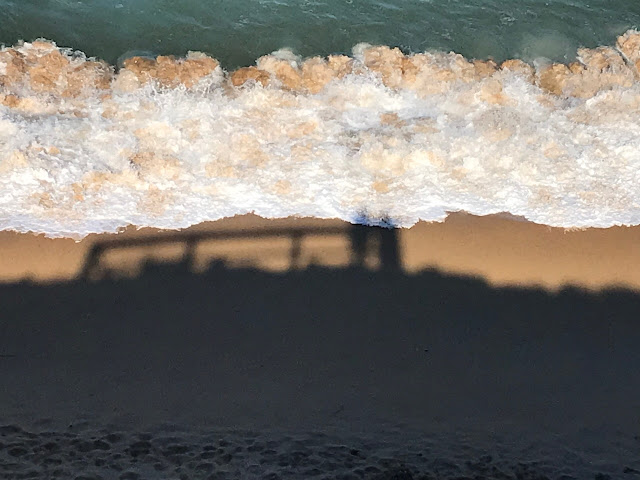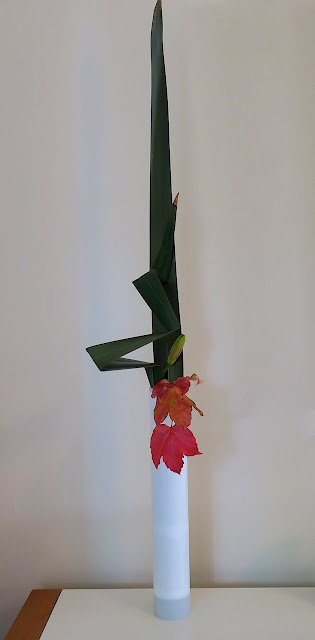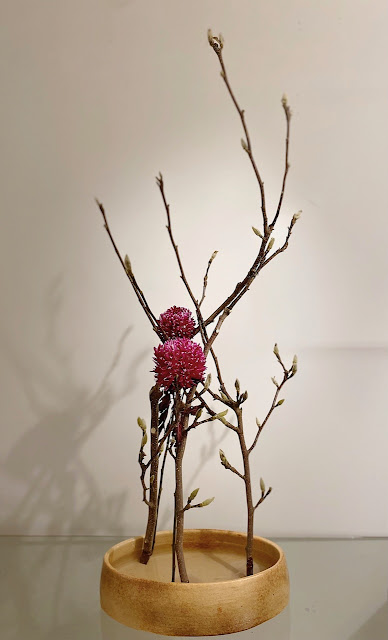USING WOOD in an IKEBANA ARRANGEMENT
STRELITZIA JUNCEA
Laurie and I were both rugged up in warm, windproof jackets. We had walked to Bell's Beach and, from the clifftop, looked down on the waves breaking just before they washed up on the sand. The sun behind us projected our shadows onto the beach
Today was a similarly cool day (13 Celsius) with bright sunshine.
In my Torquay class at the end of May I set my students the exercise of incorporating bark in their ikebana.
Róża found a long piece of bark which was able to sit securely on a flat section. Its position was stabilised by being inserted in the upright vase at the back. Two large Banksia flowers created a mass to contrast with the lines.
Pamela brought a large piece of 'paper bark' from a Melaleuca linarifolia. The two developing infloresences are from an unidentified Banksia. Unfortunately, the photo does not show that on the righthand side the bark is 'floating' slightly above the table surface.
Norma arranged her bark across the middle of the vase and focused on the autumnal colours of the Manchurian pear leaves Pyrus ussuriensis, and Strelitzia reginae flowers.
Louise used two large sheets of quite thick bark and a similarly coloured thinner bark that was able to be coiled into a loop. She added purple Statice Limonium, as her fresh material contrast.
My ikebana this week was made at a workshop of the Victorian Branch of the Sogetsu School. The double theme was 'one kind of material' and 'to be viewed from all around'.
The material I chose from the garden was Strelitzia juncea. In the photo above it is easy to see the spear-like stems which have only vestigial leaves at the tip.
These stems are relatively soft and can be easily bent. This property allowed me to make two masses from four stems. I bound the stems together and then bent them across each other in an irregular fashion, progressively building them up into a ball. Four other stems were arranged separately, projecting long lines of different lengths in different directions. As a result the finished work looked quite different from each perspective. This is a requirement in the Sogetsu curriculum. If a work is to be "viewed from all around', it must present a different aspect from each viewing angle.
The unique vessel is by the Victorian ceramic artist Mel Ogden.
23rd June 2024
WEEPING ELM
This is the final Ikebana. The two branches arise from a large ceramic 'half pillow' form. The ends of those on the left have been allowed to form sweeping lines. Those on the right have been cut straight across to the same length. Securing of the branches together has been achieved using three wooden dowels, two of which are made from bamboo skewers. In the central space between the branches I placed two short Gymea leaves Doryanthes palmeri and a mass of red Nandina "Nana". Both of these fresh materials will last without water for some time.
BARK and BANKSIA
I came across a large piece of Eucalyptus bark, with a beautiful rich red-ochre coloured underside, while walking along the creek path. Because of its size, I chose a largish bowl-shaped vessel by Isabella Wang. The full width of the bark is just over one metre. As the bark is dry and does not need water I have arranged it so that is "floating" above the vessel. Three Coastal Banksia, B. integrifolia, leaves and flowers from the garden have been added, giving fresh life to the ikebana. The harmony with the wall behind is purely coincidental.
9th June 2024
.jpeg)






































